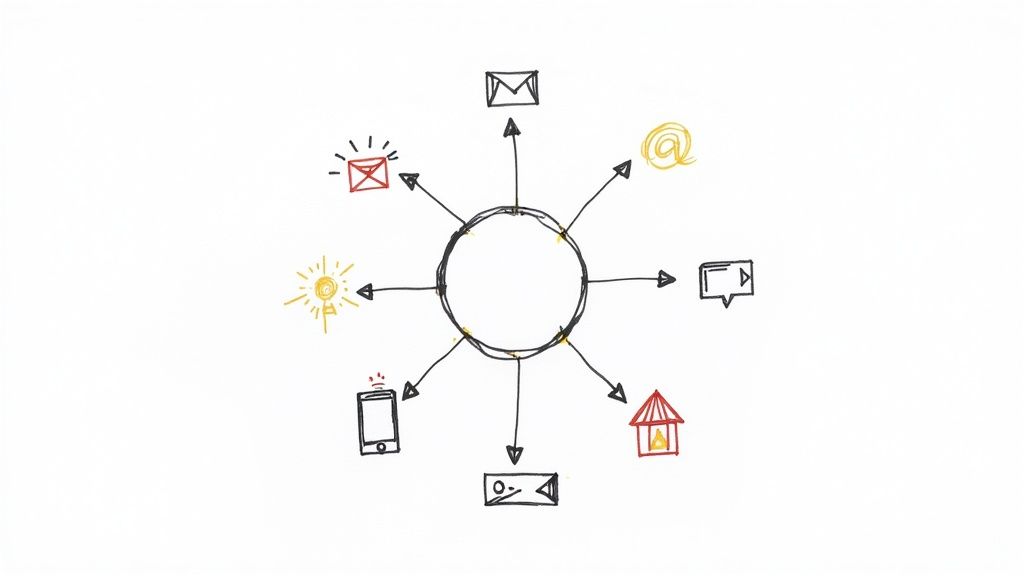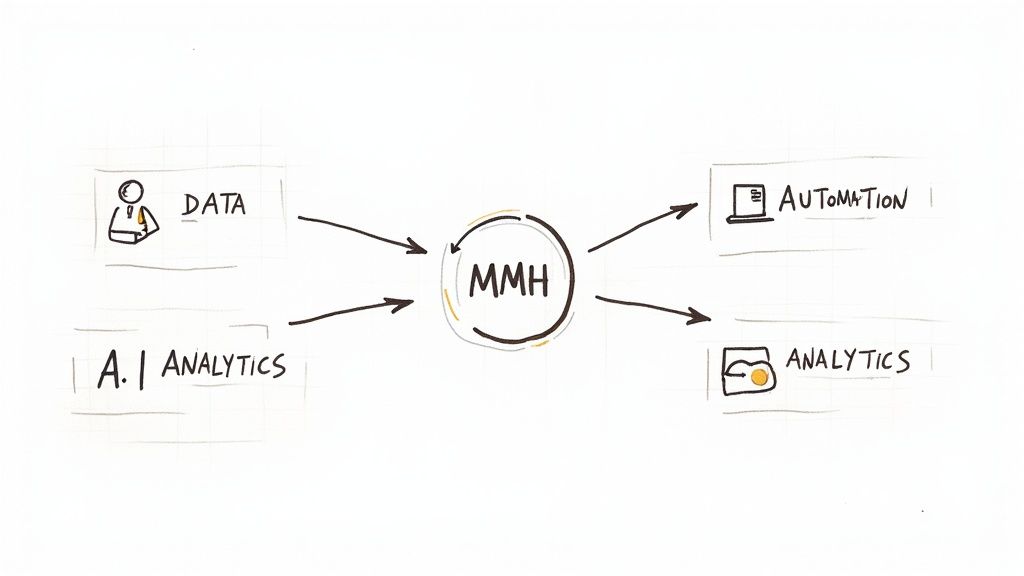
Mastering SaaS Lead Generation: Proven Strategies for Explosive Growth in 2025
Master SaaS lead generation in 2025 with proven strategies for explosive growth. Learn content marketing, SEO, ABM, and more.

Multi channel marketing is all about using multiple, independent channels to reach your customers. Imagine you have different conversations happening in different places—one on social media, another through email, and maybe one in your brick-and-mortar store. Each conversation is tailored specifically for that space.

Multi channel marketing comes down to giving your customers options. The idea is simple: be where your audience already is. This maximizes your chances to connect with them. Every channel, whether it's your website, a mobile app, or a pop-up shop, works on its own with its own strategy and goals.
This isn't the same as an omnichannel strategy, where every channel is woven into a single, seamless experience. With multi channel, the focus is on making each individual channel perform as well as it possibly can. It lets you tweak your message perfectly for each platform.
A multi channel strategy gives you the freedom to double down on your most effective platforms. For example, a clothing brand could run a flashy, product-focused campaign on Instagram while using LinkedIn to share insights about sustainable fashion. This kind of flexibility is great for targeted messaging and trying new things without overhauling your entire marketing ecosystem.
The central idea of multi channel marketing is to cast a wide net for customer engagement. It’s about being available wherever your customers might be, ensuring your brand is a visible and viable option across their preferred touchpoints.
To get the most out of this, a solid cross-platform content strategy is essential. It helps you map out how your content will look, feel, and perform on each different platform you decide to use.
As you can see, the channels don't necessarily have to talk to each other; they just need to talk to the customer in the way that makes the most sense for that specific platform.
Not long ago, a multi-channel marketing approach was a nice bonus. Something the big players did. But today? It's the cost of entry for staying in the game.
The way people shop and interact with brands has changed. They bounce between phones, laptops, and physical stores without thinking twice. Old-school, single-channel strategies don't cut it anymore. If you're only in one place, you're invisible to a massive chunk of your audience. The modern customer expects you to be everywhere they are, and a multi-channel presence is how you meet that expectation.
When you engage with customers across different platforms, it directly impacts their decision to buy from you. Seeing your brand pop up consistently builds familiarity and trust—two key ingredients for making a sale.
Companies that use three or more channels in their marketing campaigns see a mind-blowing 287% higher purchase rate than those sticking to a single channel. It's clear proof that being visible across platforms is what nudges people from just looking to actually buying.
And it doesn't stop there. These integrated strategies also pull in 166% higher engagement rates. People are more likely to respond to a brand that shows up consistently, whether in their social feed or email inbox. You can dig into more of these channel marketing statistics to see the full picture.
Ultimately, a strong multi-channel presence does more than just get your name out there; it builds real relationships, turning casual browsers into loyal customers.
Picking the right marketing channels is like packing for a trip. You don't just throw everything into a suitcase; you choose what's right for the destination. In marketing, your "destination" is your customer, so you need to show up where they already are.
Trying to be everywhere at once is a recipe for burnout. The secret is to be smart and selective. This starts with knowing your audience inside and out. If you haven't already, a great first step is learning how to create buyer personas. These detailed profiles are your roadmap, pointing you directly to the platforms your ideal customers use and trust.
Why is this so important? Take a look at the data.

As you can see, there's a direct line connecting the number of channels you use to how often customers buy. Sticking to a single channel limits your engagement and, ultimately, your sales.
Every platform has its own personality and purpose. Social media is great for sparking conversations and building community. Email marketing is like having a quiet, one-on-one coffee chat, ideal for nurturing relationships. To help you figure out where to focus, let's break down some of the most popular options.
This table gives you a quick snapshot of where different channels shine, helping you match the right platform to your audience and goals.
Choosing the right mix comes down to understanding your goals. Are you looking for immediate results, or are you playing the long game? Answering that question will make your channel selection crystal clear.
Jumping into a multi-channel strategy is exciting, but it’s not always a walk in the park. You're going to hit a few bumps, and it's best to know what they are.
One of the biggest headaches is keeping your brand consistent. It's easy for your message to get muddled when different teams manage different channels. One minute your brand sounds one way on Instagram, and the next it sounds completely different in an email. That's a surefire way to confuse your customers.
Then there's the data management nightmare. You've got customer info pouring in from social media, your website, and email. Trying to stitch that all together into a single, clear picture of your customer can feel like herding cats. If your data is a mess, any attempt at real personalization is dead on arrival.
Even with these headaches, almost every marketer will tell you it's worth it. One industry survey found that while 53% of marketing pros in the U.S. admit that building a solid strategy is tough, a massive 95% said it’s crucial for hitting their goals. The secret is knowing where to focus your energy. You can dig into the specifics in the full report on multi-channel marketing challenges.
That same report really hammers home one point: data is king. A whopping 52% of marketers pointed to data quality as the absolute most important piece of the puzzle. Right behind that was being able to accurately measure performance (50%) and having good marketing automation in place (37%).
So, what does this all mean? It means you've got to get your foundation right. Focusing on clean, high-quality data and getting the right tools to track your ROI isn't just a "nice-to-have." It's everything. Nail these basics, and you'll be turning those potential roadblocks into a major competitive advantage.
Behind every great multi-channel campaign, there's a powerful set of tools pulling the strings. To keep all the moving parts in sync, marketers lean on something called a Multi-channel Marketing Hub (MMH). Think of it as the mission control for your entire strategy.

These hubs are built to pull all your customer data into one unified spot, automate your outreach across different channels, and serve up real-time analytics. It's a total game-changer, letting you see what's actually working without having to flip between a dozen different dashboards.
It’s no surprise that these platforms are taking off. The global market for MMHs is already at USD 6 billion and is projected to climb by 17.7% each year. Why the boom? It’s simple: customers now expect personalized, relevant experiences everywhere they interact with a brand. You can explore more insights into the MMH market growth to see just how fast this space is moving.
An MMH is not just software; it's the engine that runs your multi-channel marketing strategy. It turns fragmented data into actionable insights, allowing you to deliver the right message at the right moment.
On top of that, these hubs are getting seriously smart. Many now have artificial intelligence and machine learning baked right in to boost personalization and make everything more efficient. Figuring out how to use AI in marketing can give you a massive advantage, helping you predict what customers will do next and automate tasks that used to take hours.
Let's move from theory to action. Launching your first multi-channel marketing campaign can feel overwhelming, but if you break it down into clear steps, it's much more manageable.
First things first: what are you trying to achieve? Set a clear, measurable goal. Are you shooting for a 15% bump in lead generation? Or trying to get your brand in front of a new audience? Having a specific target is your north star for every decision. A structured marketing campaign planning template can be a lifesaver.
Once you know your goal, figure out where your audience hangs out online. Then, craft a core message that stays consistent across all those platforms. The key is to keep your brand voice the same, whether you're sending a quick tweet or a detailed email newsletter.
The real magic happens when your goals, audience knowledge, and channel-specific content all click into place. This focus is what turns your marketing efforts from background noise into something that gets real results.
Finally, make sure you can track everything right from the get-go. Set up your analytics to see what’s working and what’s falling flat. This data is pure gold; it shows you exactly how to tweak your current campaign and how to make the next one even better. For ideas on creating genuine content, check out this guide to user-generated content marketing.
Think of it like this: multi-channel is like having several different conversations in separate rooms, while omnichannel is having one big, connected conversation that moves seamlessly from room to room.
With multi-channel, you're reaching customers on different platforms—like email, social media, and your blog—but each channel operates on its own. Omnichannel takes it a step further by integrating all those channels, so a customer's experience is completely connected. For example, they might see an ad on Facebook, click to your site, add an item to their cart, and then get a reminder email later. It's all one smooth journey.
Don't try to be everywhere at once! That's a surefire way to burn out. The best way to start is by figuring out where your customers actually hang out online.
Start small. Pick your top 2-3 most effective channels—maybe that's your email list and your Instagram account. Really focus on creating great content and consistent messaging for those platforms first. Once you've got a good handle on them, you can start exploring other channels as you grow.
The right metrics really depend on what you're trying to achieve, but there are a few essentials you should always keep an eye on.
Start by looking at the engagement rates on each channel (likes, comments, clicks) and the conversion rates to see which platforms are actually driving sales or sign-ups. It's also smart to track your Customer Acquisition Cost (CAC) for each channel. This tells you exactly how much you're spending to get a new customer on Facebook versus, say, email, helping you decide where to invest your budget.
Ready to build a powerful marketing strategy that gets results? At BrandBooster.ai, we use data and AI to drive real growth for your business. See how we can help by visiting us at https://www.brandbooster.ai.